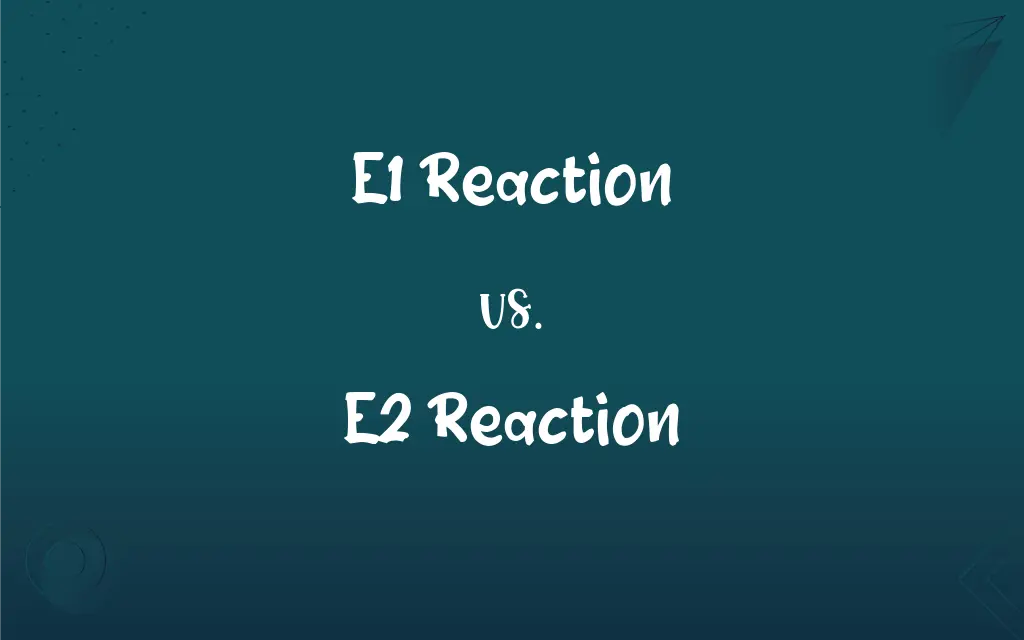E1 Reaction vs. E2 Reaction: What's the Difference?
Edited by Aimie Carlson || By Harlon Moss || Published on March 2, 2024
E1 reaction is a two-step process where the leaving group departs before the formation of the double bond, while E2 reaction is a one-step process where the leaving group departs simultaneously with the formation of the double bond.

Key Differences
E1 reaction is a unimolecular elimination process characterized by a two-step mechanism. The first step involves the departure of the leaving group, forming a carbocation intermediate. This is followed by the removal of a proton from the adjacent carbon, leading to the formation of a double bond. E2 reaction, on the other hand, is a bimolecular elimination process that occurs in a single concerted step. In this mechanism, the base abstracts a proton from the substrate while the leaving group simultaneously departs, resulting in the formation of a double bond.
E1 reaction depends solely on the concentration of the substrate, as it is a first-order reaction. In contrast, the rate of the E2 reaction depends on both the substrate and the base, making it a second-order reaction.
E1 reactions typically occur in substrates with stable carbocations, such as tertiary alkyl halides, while E2 reactions favor strong bases and less hindered substrates.
In E1 reactions, the stereochemistry is not a major concern due to the planar nature of the carbocation intermediate. However, in E2 reactions, the stereochemistry is crucial, as the proton and leaving group must be antiperiplanar for the reaction to proceed efficiently.
Comparison Chart
Mechanism
Two-step process with carbocation intermediate
One-step concerted process
ADVERTISEMENT
Rate Determining Step
Formation of carbocation
Simultaneous removal of proton and leaving group
Order of Reaction
First-order (depends on substrate concentration)
Second-order (depends on substrate and base concentrations)
Stereochemistry
Not a major concern
Requires antiperiplanar geometry
Preferred Conditions
Stable carbocations, weak bases
Strong bases, less hindered substrates
E1 Reaction and E2 Reaction Definitions
E1 Reaction
Carbocation Intermediate.
The formation of a carbocation is a key step in the E1 mechanism.
ADVERTISEMENT
E2 Reaction
Concerted Mechanism.
The E2 reaction involves the simultaneous removal of a proton and a leaving group.
E1 Reaction
Two-step Process.
The E1 reaction involves the sequential loss of a leaving group and proton abstraction.
E2 Reaction
Stereospecific.
The E2 reaction requires an antiperiplanar arrangement for efficient elimination.
E1 Reaction
Unimolecular Elimination.
The dehydration of alcohols often proceeds via an E1 mechanism.
E2 Reaction
Bimolecular Elimination.
The E2 mechanism is common in the dehydrohalogenation of alkyl halides.
E1 Reaction
First-order Elimination.
The E1 reaction rate depends solely on the concentration of the substrate.
E2 Reaction
Second-order Elimination.
The E2 reaction rate depends on the concentrations of both the substrate and the base.
E1 Reaction
Non-stereospecific.
The E1 reaction is not stereospecific due to the planar carbocation intermediate.
E2 Reaction
One-step Process.
The E2 mechanism occurs in a single step without intermediates.
FAQs
How does the rate of an E1 reaction depend on reactant concentrations?
The rate of an E1 reaction depends solely on the concentration of the substrate.
What is an E1 reaction?
An E1 reaction is a unimolecular elimination process involving a two-step mechanism with a carbocation intermediate.
What is the key intermediate in an E1 reaction?
The key intermediate in an E1 reaction is a carbocation.
Is there an intermediate in an E2 reaction?
No, there is no intermediate in an E2 reaction; it proceeds in a single step.
How does the rate of an E2 reaction depend on reactant concentrations?
The rate of an E2 reaction depends on the concentrations of both the substrate and the base.
What type of bases favor E2 reactions?
E2 reactions favor strong bases and less hindered substrates.
What type of substrates favor E1 reactions?
E1 reactions favor substrates that can form stable carbocations, such as tertiary alkyl halides.
Are E1 reactions stereospecific?
No, E1 reactions are not stereospecific due to the planar nature of the carbocation intermediate.
How does the solvent affect E1 and E2 reactions?
Polar protic solvents favor E1 reactions by stabilizing the carbocation, while polar aprotic solvents favor E2 reactions by enhancing the nucleophilicity of the base.
What is an E2 reaction?
An E2 reaction is a bimolecular elimination process occurring in a single concerted step without intermediates.
Can E2 reactions be catalyzed by acids?
No, E2 reactions are typically not catalyzed by acids, as they require strong bases for proton abstraction.
Can E1 reactions occur with primary substrates?
E1 reactions are less favorable with primary substrates due to the instability of primary carbocations.
How do temperature and heat affect E1 and E2 reactions?
Both E1 and E2 reactions are generally favored by higher temperatures, which increase the energy available for overcoming activation barriers.
Can E1 and E2 reactions be reversible?
E1 reactions can be reversible, especially in the presence of a nucleophile. E2 reactions are generally irreversible.
Can E2 reactions occur with tertiary substrates?
E2 reactions can occur with tertiary substrates, but they may be hindered due to steric effects.
What is the role of the leaving group in E1 and E2 reactions?
In both E1 and E2 reactions, the leaving group departs, facilitating the formation of a double bond.
Can E1 reactions be catalyzed by acids?
Yes, E1 reactions can be catalyzed by acids, which promote the formation of carbocations.
Are E2 reactions stereospecific?
Yes, E2 reactions are stereospecific and require an antiperiplanar geometry for efficient elimination.
What is the significance of the antiperiplanar geometry in E2 reactions?
The antiperiplanar geometry ensures proper orbital alignment for efficient overlap and elimination in E2 reactions.
What is the relationship between E1 and E2 reactions and Zaitsev's rule?
Zaitsev's rule predicts that the more substituted alkene will be the major product in both E1 and E2 reactions, as it is more stable.
About Author
Written by
Harlon MossHarlon is a seasoned quality moderator and accomplished content writer for Difference Wiki. An alumnus of the prestigious University of California, he earned his degree in Computer Science. Leveraging his academic background, Harlon brings a meticulous and informed perspective to his work, ensuring content accuracy and excellence.
Edited by
Aimie CarlsonAimie Carlson, holding a master's degree in English literature, is a fervent English language enthusiast. She lends her writing talents to Difference Wiki, a prominent website that specializes in comparisons, offering readers insightful analyses that both captivate and inform.































































